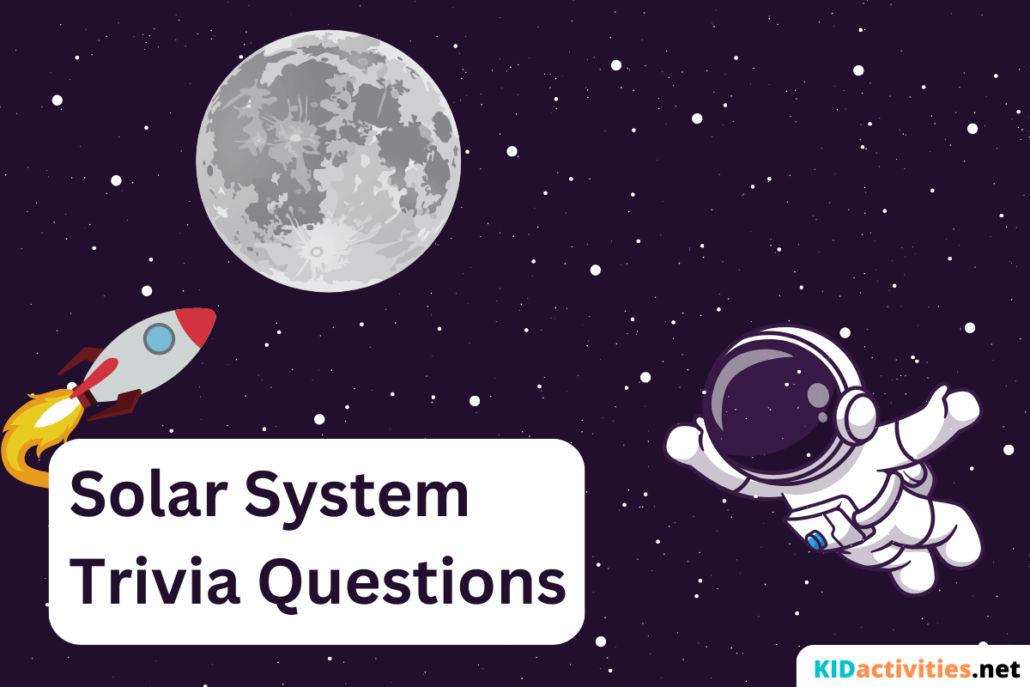Does your child have their head in the clouds? Use their stargazing tendencies to their advantage! Quiz your child with these questions about all things planetary, starry, and spacy. They’ll think you’re out of this world!
In this set of trivia questions, you will learn fascinating facts about each planet in our solar system, the life span of a star, black holes, and more. Impress your friends by knowing “everything in the galaxy!”
Perplexing Planets
Q: How many planets are in our solar system?
a. 5
b. 8
c. 9
d. 12
Q: Which former planet was deemed a “dwarf planet” in 2006?
a. Venus
b. Mercury
c. Saturn
d. Pluto
Q: Approximately how much of Earth’s surface is covered in water?
a. 10%
b. 33%
c. 71%
d. 99%
Q: Which planet has the longest day in our solar system, equivalent to 243 days on Earth?
a. Saturn
b. Venus
c. Mars
d. Uranus
Q: Which planet could be characterized as, “blue, icy, and windy?”
a. Neptune
b. Earth
c. Venus
d. Jupiter
Q: The planet Saturn is famously known for its rings that wrap around the planet. What are these rings made of?
a. Stars
b. Space debris from former planets
c. Fire
d. Ice, dust, and rocks
Q: Jupiter, the largest planet in our solar system, is named after whom?
a. The scientist who discovered the planet
b. The main Roman god
c. The small particles that make up the planet
d. The king of Rome during the time the planet was discovered
Q: Mercury is known not only as the smallest planet but also as the fastest planet. What is the speed at which Mercury rotates around the sun?
a. 29 miles per second
b. 29 miles per minute
c. 29 miles per hour
d. 29 miles per day
Q: Mars is known as the “red planet.” What makes the planet appear red?
a. Swarms of ladybugs who inhabit the planet
b. The lava that covers the surface of the planet
c. Firestorms
d. Soil with iron and rust that is blowing in wind storms
Q: Due to the large volume of Uranus, how many planet Earths could fit inside the dimensions of this planet?
a. 12
b. 31
c. 45
d. 63
Q: What device can be used to see stars more closely and clearly?
a. Thermometer
b. Microscope
c. Telescope
d. Magnifying glass
Q: Which star is the center of our solar system?
a. The Sun
b. The North Star
c. The Milky Way
d. The Big Dipper
Q: What are the two main elements in stars?
a. Oxygen & Hydrogen
b. Calcium & Potassium
c. Sulfur & Phosphorus
d. Hydrogen & Helium
Q: What happens to the material left over from stars that “die?”
a. It eventually dissipates entirely
b. It floats in space forever
c. It forms new stars
d. It is absorbed by the son
Q: What determines the color of a star?
a. The materials it is made of
b. Its level of brightness
c. The temperature of the star in its photosphere
d. It’s distance from the earth
Q: What is a supernova?
a. A family of stars that are born in a cluster
b. A collision between two planets
c. A trip that astronauts take into space
d. A colorful explosion of a dying star
Q: How old is the average star?
a. 1-10 years
b. 1-10 thousand years
c. 1-10 million years
d. 1-10 billion years
Q: What is the most common type of star?
a. Red dwarf
b. White dwarf
c. Brown dwarf
d. Yellow dwarf
Q: About how many stars can the human eye see in the sky at night?
a. Around 200
b. Around 2000
c. Around 200,000
d. Around 2 million
Q: Which star is closest to the earth?
a. The Sun
b. Proxima Centauri
c. Alpha Centauri A
d. Alpha Centauri B
Stupendous Space
Q: What is a black hole?
a. Dark craters on the moon’s surface
b. A round orb that floats through space
c. An area of gravity that nothing escapes from
d. A small pit of dark matter in space
Q: What shape is the Milky Way?
a. Spiral
b. Triangular
c. Spherical
d. Rectangular
Q: What does the word ‘solar’ mean?
a. Relating to the moon
b. Relating to the stars
c. Relating to the earth
d. Relating to the sun
Q: Who was the first astronaut to land on the moon?
a. Neil Armstrong
b. Sally Ride
c. Buzz Aldrin
d. Mae Jemison
Q: Between which two planets is the Asteroid Belt located?
a. Mercury and Venus
b. Venus and Earth
c. Earth and Mars
d. Mars and Jupiter
Q: What citrus fruit is the moon shaped like?
a. Lemon
b. Orange
c. Lime
d. Grapefruit
Q: How many tails does a comet have?
a. One
b. Two
c. Three
d. Four
Q: How much does the Willamette Meteorite weigh, the largest ever found in the United States?
a. 15 pounds
b. 150 pounds
c. 15,000 pounds
d. 15.5 tons
Q: What is the longest that a total solar eclipse can last?
a. 30 seconds
b. 5 minutes
c. 7.5 minutes
d. 2 hours
Q: What is the temperature in space?
a. -453.8 degrees Fahrenheit
b. -101.1 degrees Fahrenheit
c. 32 degrees Fahrenheit
d. 96.1 degrees Fahrenheit
Status: Space Cadet
Next time you’re feeling spacey, come back down to Earth with these trivia questions to test your expertise on our extraordinary galaxy!

